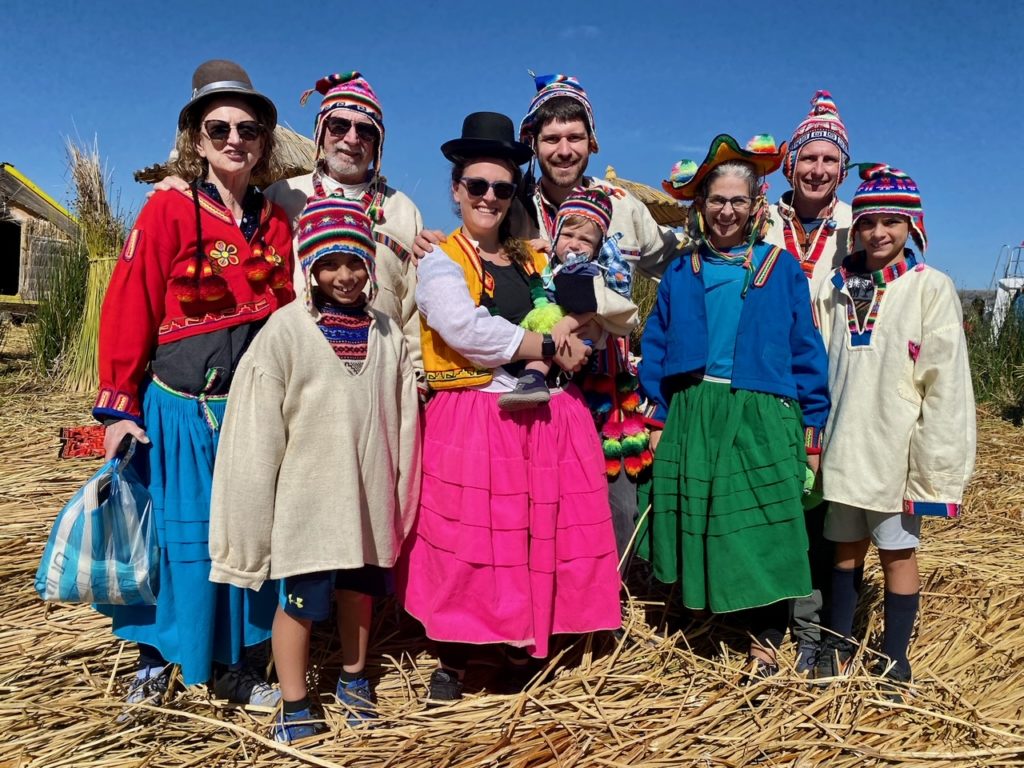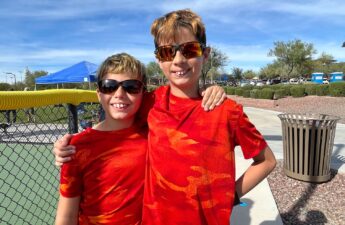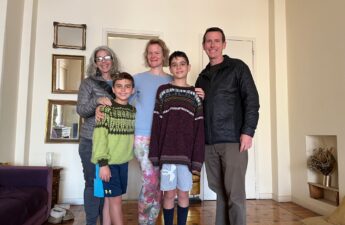After we took the evacuation train out of Aguas Calientes we took a 7 am tour bus from Cusco to Puno. The bus company is called Turismo Mer. The bus had about 40 people on it. The seats were comfortable and there was a bathroom on board (for peeing only). The trip from Cusco to Puno took about 11 hours because we made several stops along the way at archaeological sites and churches, and we had a nice long lunch.

There is an option to take a train from Cusco to Puno or a bus that does not stop. Taking the tour with stops was the best option for our group, especially since we had our 1-year-old nephew, Milo, with us.
Our first stop was in Andahuaylillas, a small farming town 40-minutes south of Cusco. We toured the Temple of San Pedro and San Pablo called the Sixtine Chapel of America. The temple was built in the late 1500s. Paintings and ornate decorations cover every inch of the wall. Next to the temple is a small exhibit about aliens. Our tour guide was enthusiastic about extraterestial life.



Our second stop was at the Raqchi archeological complex. It is another ancient Inca settlement with remains of a large temple, residences and storage buildings.


We had lunch at a nice restaurant with llamas, a trampoline and playground in the backyard. Lucas pulled out his backflip on the trampoline.





After lunch we stoped at La Raya, the border between Cusco and Puno. The elevation is about 12,000 feet, and you can feel it. We bought Milo a Llama (stuffed animal) from a vendor at the site. We visited a few more sites and museums before arriving at our hotel in Puno at 6:30 pm. We stayed at the Casa Andi a Premium Puno. It is a nice hotel on the Lake Titicaca. The restaurant is good for dinner, but the breakfast is not great.


The next day we had another early tour. Our guide, Herber, picked us up at the hotel at 7:30 am. We walked down the dock to our boat. The boat seats 32, but we were the only people on it. Our boat driver and his wife are from the Tequile islands.



Our first stop was on the floating island of Uruo. There are hundreds of floating islands in Lake Titicaca that are inhabited. The people on the island fish, hunt and make most of their money through tourism. The island we stopped on had six families living on it. We were greeted by the president of the island. A president is elected once a year.







The president, Jesus, gave a presentation about how the island is constructed and how they maintain it. The island floats on the roots of reeds. Dried reeds are layered on top of the roots as a floor. Reeds must be added to the floor every couple of weeks, and parts of the island must be cut because the island rots and would sink without adding to it.
We learned about how they cook. We got to see inside their homes and try on traditional clothing. There are schools on some of the islands, but many children go to school on the mainland in Puno. The islands do have electricity generated from solar panels.



We purchased a few items from them. Henry got a flute. Lucas bought two necklaces and Michael got a beautiful weaving. After touring the island, we took a ride on their reed boat to the main island where we got our passports stamped for S/1 each.



Our next stop was an hour and forty-minute boat ride to Taquile island. Our guide is from Amantani Island, across from Taquile. Taquile has 2,700 inhabitants. The president of this island greeted us when we came to the island. That is one of his jobs. The president is elected once a year at a meeting. He is not paid for the job. The hike up to the top of the island is not easy because of the altitude.

Our guide told us about the traditions of the island. The people on Taquile speak Quechua and wear traditional clothing. Five different hats are worn by the men to represent their status:
- The president wears two hats (Presidents’ sons wear a special hat too, even if they are not married).
- Past presidents wear a unique hat.
- Married men have a hat.
- Single boys looking for a match wear a specific type of hat (the tighter the weaving, the more it stands up and the better his prospects).
- There are hats for young boys and girls.
Women cut their hair twice in their lives. The first time is to provide hair for her husband to weave into his belt. The second time is to make extensions that the husband wears during celebrations and important ceremonies.
When a man finds his match, he has to go to the parents of the girl and perform a test. He must put water in his hat, and the water must stay in the hat for an agreed amount of time (that is why the tight weaving is important). If the suitor fails the test, he may be able to try again once he weaves a new hat. The girl goes to live with the bouts family once they are married because the boys inherit land.
The wedding ceremony lasts several days and includes a period where the couples cannot smile, speak or use their hands. Their hands stay against their bodies. The parents decide when they eat and go to the bathroom. They are not even allowed to sleep. It is another test of their commitment. After that, there is a lot of celebrating.
We saw and participated in a traditional dance show. We ate a delicious lunch overlooking the lake. We also saw demonstrations of how they make shampoo and soap from plants and how they weave.






We took a nice walk along the island and saw sheep and families. It was a lovely day, and we are honored to get a glimpse into the lives of these islanders. Their lives are so different from our lives.



The next day we said goodbye to my dad, Kay, my sister, and her family. It was a busy and exciting eight days. They flew to Lima for one day before heading home. We got organized and headed to the border and Bolivia!



